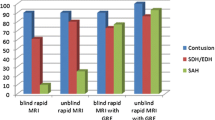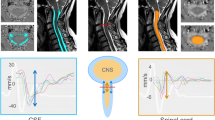Abstract
Purpose
To avoid contrast administration in spontaneous intracranial hypotension (SIH), some studies suggest accepting diffuse pachymeningeal hyperintensity (DPMH) on non-contrast fluid-attenuated inversion recovery (FLAIR) as an equivalent sign to diffuse pachymeningeal enhancement (DPME) on contrast-enhanced T1WI (T1ce), despite lacking thorough performance metrics. This study aimed to comprehensively explore its feasibility.
Methods
In this single-center retrospective study, between April 2021 and November 2023, brain MRI examinations of 43 patients clinically diagnosed with SIH were assessed using 1.5 and 3.0 Tesla MRI scanners. Two radiologists independently assessed the presence or absence of DPMH on FLAIR and DPME on T1ce, with T1ce serving as a gold-standard for pachymeningeal thickening. The contribution of the subdural fluid collections to DPMH was investigated with quantitative measurements. Using Cohen’s kappa statistics, interobserver agreement was assessed.
Results
In 39 out of 43 patients (90.7%), pachymeningeal thickening was observed on T1ce. FLAIR sequence produced an accuracy, sensitivity, specificity, positive predictive value, and negative predictive value of 72.1%, 71.8%, 75.0%, 96.6%, and 21.4% respectively, for determining pachymeningeal thickening. FLAIR identified pachymeningeal thickening in 28 cases; however, among these, 21 cases (75%) revealed that the pachymeningeal hyperintense signal was influenced by subdural fluid collections. False-negative rate for FLAIR was 28.2% (11/39).
Conclusion
The lack of complete correlation between FLAIR and T1ce in identifying pachymeningeal thickening highlights the need for caution in removing contrast agent administration from the MRI protocol of SIH patients, as it reveals a major criterion (i.e., pachymeningeal enhancement) of Bern score.




Similar content being viewed by others
Data availability
The datasets generated during the current study are available from the corresponding author on reasonable request.
Abbreviations
- SIH:
-
Spontaneous intracranial hypotension
- CSF:
-
Cerebrospinal fluid
- DPME:
-
Diffuse pachymeningeal enhancement
- DPMH:
-
Diffuse pachymeningeal hyperintensity
- FLAIR:
-
Fluid-attenuated inversion recovery
- T1ce:
-
Contrast-enhanced T1-weighted imaging
References
Farnsworth PJ, Madhavan AA, Verdoorn JT, Shlapak DP, Johnson DR, Cutsforth-Gregory JK, Brinjikji W, Lehman VT (2023) Spontaneous intracranial hypotension: updates from diagnosis to treatment. Neuroradiology 65(2):233–243. https://doi.org/10.1007/s00234-022-03079-5
Kranz PG, Amrhein TJ, Schievink WI, Karikari IO, Gray L (2016) The “Hyperdense Paraspinal Vein” Sign: A Marker of CSF-Venous Fistula. AJNR Am J Neuroradiol 37(7):1379–1381. https://doi.org/10.3174/ajnr.A4682
Schievink WI, Maya MM, Moser FG, Simon P, Nuño M (2022) Incidence of spontaneous intracranial hypotension in a community: Beverly Hills, California, 2006-2020. Cephalalgia 42(4–5):312–316. https://doi.org/10.1177/03331024211048510
D’Antona L, Jaime Merchan MA, Vassiliou A, Watkins LD, Davagnanam I, Toma AK, Matharu MS (2021) Clinical presentation, investigation findings, and treatment outcomes of spontaneous intracranial hypotension syndrome: a systematic review and meta-analysis. JAMA Neurol 78(3):329–337. https://doi.org/10.1001/jamaneurol.2020.4799
Forghani R, Farb RI (2008) Diagnosis and temporal evolution of signs of intracranial hypotension on MRI of the brain. Neuroradiology 50(12):1025–1034. https://doi.org/10.1007/s00234-008-0445-z
Carlton Jones L, Butteriss D, Scoffings D (2022) Spontaneous intracranial hypotension: the role of radiology in diagnosis and management. Clin Radiol 77(3):e181–e194. https://doi.org/10.1016/j.crad.2021.11.007
Dobrocky T, Grunder L, Breiding PS, Branca M, Limacher A, Mosimann PJ, Mordasini P, Zibold F, Haeni L, Jesse CM, Fung C, Raabe A, Ulrich CT, Gralla J, Beck J, Piechowiak EI (2019) Assessing spinal cerebrospinal fluid leaks in spontaneous intracranial hypotension with a scoring system based on brain magnetic resonance imaging findings. JAMA Neurol 76(5):580–587. https://doi.org/10.1001/jamaneurol.2018.4921
Tosaka M, Sato N, Fujimaki H, Tanaka Y, Kagoshima K, Takahashi A, Saito N, Yoshimoto Y (2008) Diffuse pachymeningeal hyperintensity and subdural effusion/hematoma detected by fluid-attenuated inversion recovery MR imaging in patients with spontaneous intracranial hypotension. AJNR Am J Neuroradiol 29(6):1164–1170. https://doi.org/10.3174/ajnr.A1041
Cheema S, Anderson J, Angus-Leppan H, Armstrong P, Butteriss D, Carlton Jones L, Choi D, Chotai A, D’Antona L, Davagnanam I, Davies B, Dorman PJ, Duncan C, Ellis S, Iodice V, Joy C, Lagrata S, Mead S, Morland D, Nissen J, Pople J, Redfern N, Sayal PP, Scoffings D, Secker R, Toma AK, Trevarthen T, Walkden J, Beck J, Kranz PG, Schievink W, Wang SJ, Matharu MS (2023) Multidisciplinary consensus guideline for the diagnosis and management of spontaneous intracranial hypotension. J Neurol Neurosurg Psychiatry 94(10):835–843. https://doi.org/10.1136/jnnp-2023-331166
Michali-Stolarska M, Bladowska J, Stolarski M, Sąsiadek MJ (2017) Diagnostic imaging and clinical features of intracranial hypotension - review of literature. Pol J Radiol 15(82):842–849. https://doi.org/10.12659/PJR.904433
Schievink WI (2006) Spontaneous spinal cerebrospinal fluid leaks and intracranial hypotension. JAMA 295(19):2286–2296. https://doi.org/10.1001/jama.295.19.2286
Schievink WI (2021) Spontaneous Intracranial Hypotension. N Engl J Med 385(23):2173–2178. https://doi.org/10.1056/NEJMra2101561
Wang SJ (2021) Spontaneous intracranial hypotension. Continuum (Minneap Minn) 27(3):746–766. https://doi.org/10.1212/CON.0000000000000979
Farb RI, Forghani R, Lee SK, Mikulis DJ, Agid R (2007) The venous distension sign: a diagnostic sign of intracranial hypotension at MR imaging of the brain. AJNR Am J Neuroradiol 28(8):1489–1493. https://doi.org/10.3174/ajnr.A0621
Kataoka H, Tanizawa E, Ueno S (2007) Spontaneous intracranial hypotension is associated with a risk of venous sinus thrombosis and subdural hematoma. Cerebrovasc Dis 23(4):315–317. https://doi.org/10.1159/000098446
Wang YF, Fuh JL, Lirng JF, Chang FC, Wang SJ (2007) Spontaneous intracranial hypotension with isolated cortical vein thrombosis and subarachnoid haemorrhage. Cephalalgia 27(12):1413–1417. https://doi.org/10.1111/j.1468-2982.2007.01437.x
Webb AJ, Flossmann E, Armstrong RJ (2015) Superficial siderosis following spontaneous intracranial hypotension. Pract Neurol 15(5):382–384. https://doi.org/10.1136/practneurol-2015-001169
Alvarez-Linera J, Escribano J, Benito-León J, Porta-Etessam J, Rovira A (2000) Pituitary enlargement in patients with intracranial hypotension syndrome. Neurology 55(12):1895–1897. https://doi.org/10.1212/wnl.55.12.1895
O’Cearbhaill RM, Haughey AM, Willinsky RA, Farb RI, Nicholson PJ (2023) The presence of pachymeningeal hyperintensity on non-contrast flair imaging in patients with spontaneous intracranial hypotension. Neuroradiology 65(5):893–898. https://doi.org/10.1007/s00234-023-03128-7
Quintas-Neves M (2023) Diffuse pachymeningeal T2-FLAIR hyperintensity in spontaneous intracranial hypotension: to obviate gadolinium administration or not. Neuroradiology 65(9):1317–1318. https://doi.org/10.1007/s00234-023-03167-0
Mark IT, Dillon WP, Richie MB, Villanueva-Meyer JE (2022) MRI findings after recent image-guided lumbar puncture: the rate of dural enhancement and subdural collections. AJNR Am J Neuroradiol 43(5):784–788. https://doi.org/10.3174/ajnr.A7496
Benson JC, Madhavan AA, Cutsforth-Gregory JK, Johnson DR, Carr CM (2023) The monro-kellie doctrine: a review and call for revision. AJNR Am J Neuroradiol 44(1):2–6. https://doi.org/10.3174/ajnr.A7721
Mokri B, Piepgras DG, Miller GM (1997) Syndrome of orthostatic headaches and diffuse pachymeningeal gadolinium enhancement. Mayo Clin Proc 72(5):400–413. https://doi.org/10.4065/72.5.400
Funding
The authors did not receive support from any organization for the submitted work.
Author information
Authors and Affiliations
Contributions
The first draft of the manuscript was written by [Sabahattin Yuzkan]. [Sabahattin Yuzkan] and [Burak Kocak] contributed to the study conception and design. [Sabahattin Yuzkan], [Burak Kocak], [Tahsin Benlice], [Tevfik Guzelbey], [Serdar Balsak], [Mehmed Fatih Yilmaz], [Oner Ozbey], [Merve Sam Ozdemir], [Uluc Ozkiziltan], [Yavuz Altunkaynak], and [Ozgur Kilickesmez] contributed to the material preparation, data collection, and analysis. All authors made substantial contributions to the interpretation of data. All authors critically revised manuscript. All authors approved the version to be published and agree to be accountable for all aspects of the work in ensuring that questions related to the accuracy or integrity of any part of the work are appropriately investigated and resolved.
Corresponding author
Ethics declarations
Conflict of interest
The authors declare no conflict of interest.
Competing interests
The authors have no relevant financial or non-financial interests to disclose.
Ethical approval
All procedures performed in studies involving human participants were in accordance with the ethical standards of the institutional and/or national research committee and with the Helsinki declaration and its later amendments or comparable ethical standards.
This study was performed in line with the principles of the Declaration of Helsinki. Institutional review board approval was granted by the medical Ethics Committee (decision no: 534; decision date: 08/11/2023).
This article does not contain any studies with animals performed by any of the authors.
Consent to participate
Written informed consent necessity was waived by the ethics committee as the study had retrospective design and all data were anonymized.
Additional information
Publisher’s Note
Springer Nature remains neutral with regard to jurisdictional claims in published maps and institutional affiliations.
Rights and permissions
Springer Nature or its licensor (e.g. a society or other partner) holds exclusive rights to this article under a publishing agreement with the author(s) or other rightsholder(s); author self-archiving of the accepted manuscript version of this article is solely governed by the terms of such publishing agreement and applicable law.
About this article
Cite this article
Yuzkan, S., Benlice, T., Guzelbey, T. et al. Spontaneous intracranial hypotension: Exploring the viability of non-contrast FLAIR as a substitute for contrast-enhanced T1WI in assessing pachymeningeal thickening. Neuroradiology (2024). https://doi.org/10.1007/s00234-024-03359-2
Received:
Accepted:
Published:
DOI: https://doi.org/10.1007/s00234-024-03359-2




